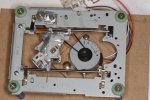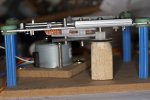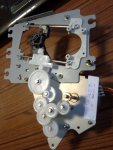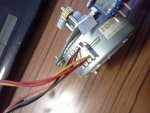Finally got the stepper working.
1) Altered the code to just run an infinite loop without any IR or such to complicate things or require pressing buttons. Added longer pauses, if for nothing else than to provide me time to take multimeter readings.
2) Still didn't work but confirmed the darlington was firing 4V on outputs in sequence but amperage was between 200mA and 270mA. I assumed the 1A rating of the stepper is a max consumption but I now think the rating is an operational demand.
3) Hooked up the battery pack of 3x 1800mAh NiMH and noticed motor now jiggling and with a few combinations motor is now stepping properly.
So the assumption about current demand of the stepper being a max demand seems wrong, and this would only be made worse running at 5V instead of 12V which would mean current draw is 12/5 x 1 or over 2A. Even if I hooked up a 12V supply the darlington, as dsvilko alluded to, is overloading it's rating of 0.5A. To persevere with this motor, even with a 12V supply, would require paralelling the darlington or 1 of the high current ones to handle the current or maybe mosfets etc. Which of course means re-doing the circuit as well as supplying cut down to the Picaxe etc. Too much work and thought for the moment.
So bottom line is I'll wait for my 5V stepper to arrive. Given the size of the thing in a picture I'd say it's current demand is much lower (going on size as a measure of power, which is mostly true for standard motors). However this motor, seemingly for the robotics market would I think work in a project moving the camera using a flatbed scanner as the carriage (like I saw elsewhere).
Many thanks for your thoughts. Just being able to cut things down to bare minimum to test parts in isolation is always good.
1) Altered the code to just run an infinite loop without any IR or such to complicate things or require pressing buttons. Added longer pauses, if for nothing else than to provide me time to take multimeter readings.
2) Still didn't work but confirmed the darlington was firing 4V on outputs in sequence but amperage was between 200mA and 270mA. I assumed the 1A rating of the stepper is a max consumption but I now think the rating is an operational demand.
3) Hooked up the battery pack of 3x 1800mAh NiMH and noticed motor now jiggling and with a few combinations motor is now stepping properly.
So the assumption about current demand of the stepper being a max demand seems wrong, and this would only be made worse running at 5V instead of 12V which would mean current draw is 12/5 x 1 or over 2A. Even if I hooked up a 12V supply the darlington, as dsvilko alluded to, is overloading it's rating of 0.5A. To persevere with this motor, even with a 12V supply, would require paralelling the darlington or 1 of the high current ones to handle the current or maybe mosfets etc. Which of course means re-doing the circuit as well as supplying cut down to the Picaxe etc. Too much work and thought for the moment.
So bottom line is I'll wait for my 5V stepper to arrive. Given the size of the thing in a picture I'd say it's current demand is much lower (going on size as a measure of power, which is mostly true for standard motors). However this motor, seemingly for the robotics market would I think work in a project moving the camera using a flatbed scanner as the carriage (like I saw elsewhere).
Many thanks for your thoughts. Just being able to cut things down to bare minimum to test parts in isolation is always good.






